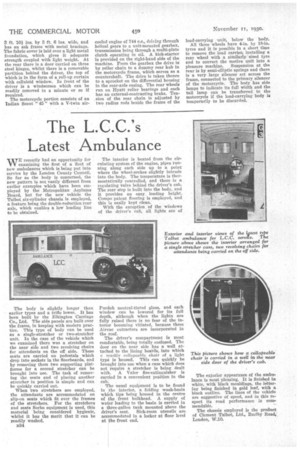The L.C.C' .s Latest Ambulance
Page 84

If you've noticed an error in this article please click here to report it so we can fix it.
WE recently had an opportunity for examining the first of a fleet of new ambulances which is being put into service by the London County Council. So far as the body is concerned, the new pattern is not vastly different from earlier examples which have been employed by the Metropolitan .Asylums Board, but for the new vehicle the Talbot.six-cylinder chassis is employed, a feature being, the double-reduction rear axle, which enables a low loading line
to be obtained. • The body is slightly longer than earlier types and a trifle lower. It has been built by the Elkington Carriage Co., Ltd. The side panels are built over the frame, in keeping with modern practice. This type of body can be used as a single-stretcher or two-stretcher unit. In the case of the vehicle which we examined there was a stretcher on the near side and two revolving chairs for attendants on the off side. These scats are carried on pedestals which drop into sockets in the floorboards, and by removing them two supporting platforms for a second stretcher can be brought into use. The task of removing the seats and of placing another stretcher in position is simple and can be quickly carried out.
When two stretchers are employed, the attendants are accommodated on slip-on seats which fit over the frames of the stretchers. For the stretchers and seats Sorbo equipment is used, this material being considered hygienic, 'whilst it has• the merit that it can be readily washed.
]334 The interior is heated from the circulating system of the engine, pipes running along each side up to a point where the wheel-arches slightly intrude into the body. The temperature is thermostatically controlled, and there is a regulating valve behind the driver's cab. The rear step is built into the body, and it provides an easy loading height. Compo patent flooring is employed, and this is easily kept clean. .
With the exception of the windows of the driver's cab, all lights are of Purdah neutral-tinted glass, and each window can be lowered for its full depth, although when the lights are fully raised there is no fear of the interior becoming vitiated, because three Airvac extractors are incorporated in the roof.
The driver's compartment is most comfortable, being totally enclosed. The door on the near side has a well attached to the lining bolas, into which a readily collapsahle chair of a light type is housed. This can quickly be brought into use when a case which does not require a stretcher is being dealt with. A Valor fire-extinguisher is carried in a convenient position in the cab.
The usual equipment is to be found in the interior, a folding wash-basin which tips being housed in the centre of the front bulkhead. A supply of water leading to the basin is carried in a three-gallon tank mounted above the
driver's seat. Sick-room utensils are accommodated in a locker at floor level at the front end. The exterior appearance of the ambulance is most pleasing. It is finished in white, with black mouldings, the lettering being finished in gold leaf, with a black outline. The lines of the vehicle are suggestive of speed, and in this respect its road performance is commendable.
The chassis employed is the product of Clement Talbot, Ltd., Barlby Road, London, W.10.




















































































































































